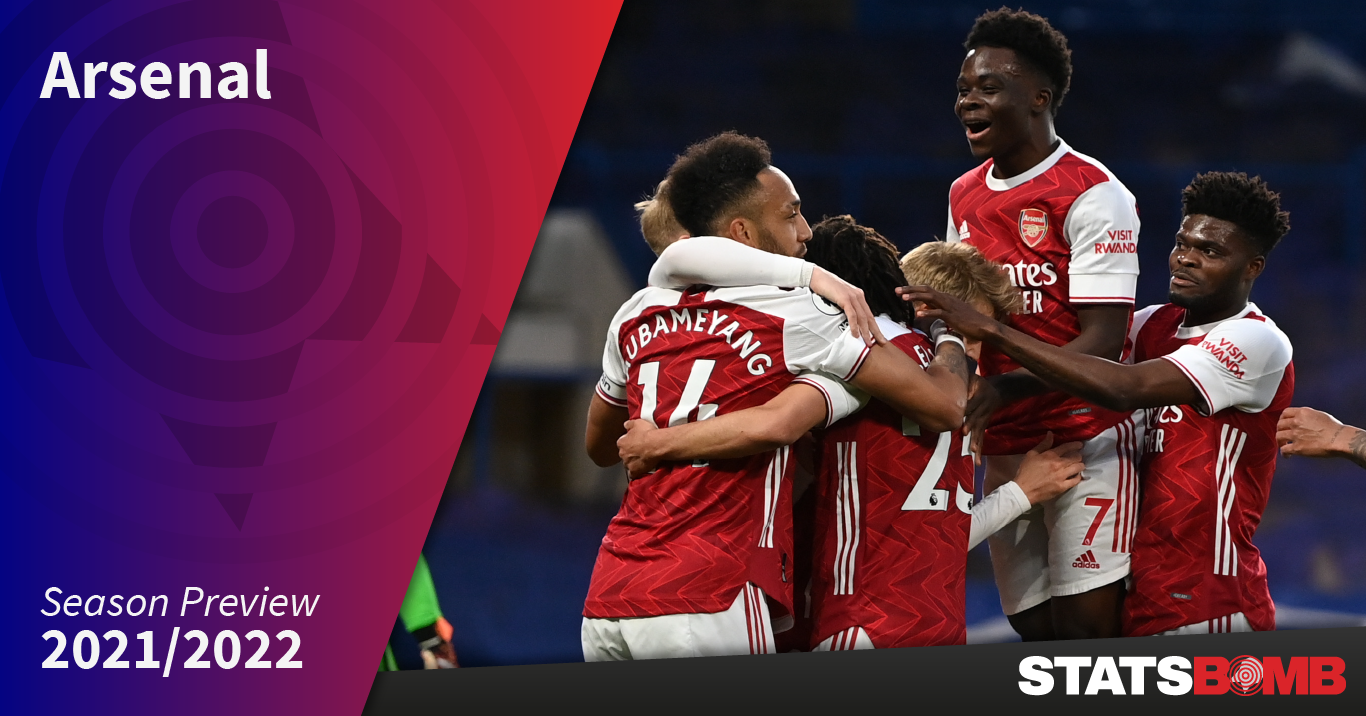As we enter Year Three of Mikel Arteta’s reign as Arsenal manager, it feels like this season could be make or break for his tenure. This time around there’s no recent FA Cup win to point to as a sign of progress; it has to be evident out on the pitch. Can Arteta achieve that?
One of the biggest issues facing Arteta when he joined was that Arsenal’s metrics had been not great for quite some time. Despite the clear positive of the style of play the Spaniard was attempting to implement, there was an alarming drop in performance at the start of the 2020/21 season:
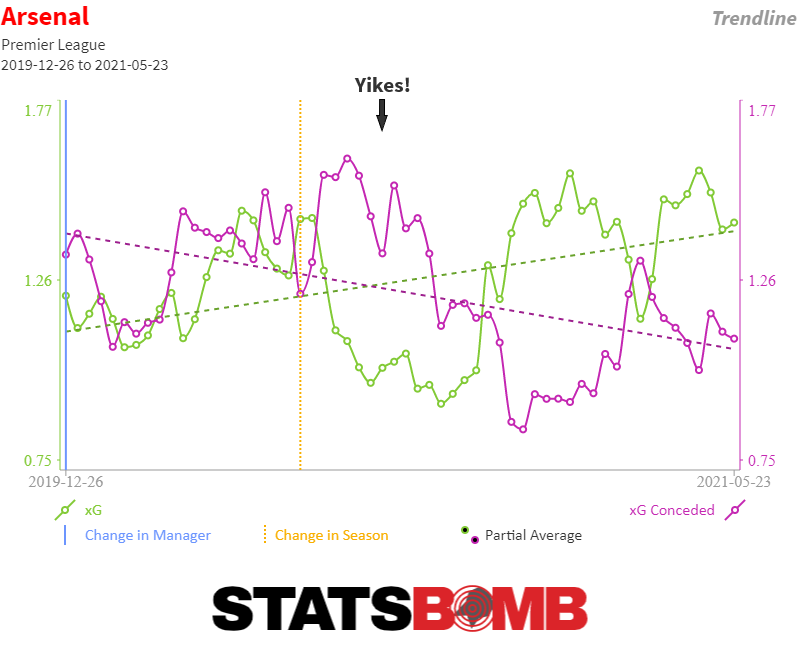
Thankfully, in December -- a full year after his appointment -- he seemingly stumbled upon a formula that worked. From that point on, whilst results have continued to be hit and miss, their metrics have been much improved in both attack and defence. But they still need to maintain that into the new season, a campaign where they won’t be beholden to midweek trips to the continent. How will the increase in training and preparation time manifest itself? Let’s take a look at what Arteta should be looking at if he wants to take the Gunners back into Europe.
How do Arsenal improve?
In last season's StatsBomb preview, Ted highlighted three key areas that Arsenal needed to improve: player recruitment, defensive style, and set pieces. The bad news? Player recruitment was a mixed bag. The good news? The latter two did show signs of improvement.
Arsenal’s overall expected goal (xG) difference improved from -0.09 per game in 2019/20 to +0.18 per game in 2020/21. The graphic below highlights the general trend of improving performances:
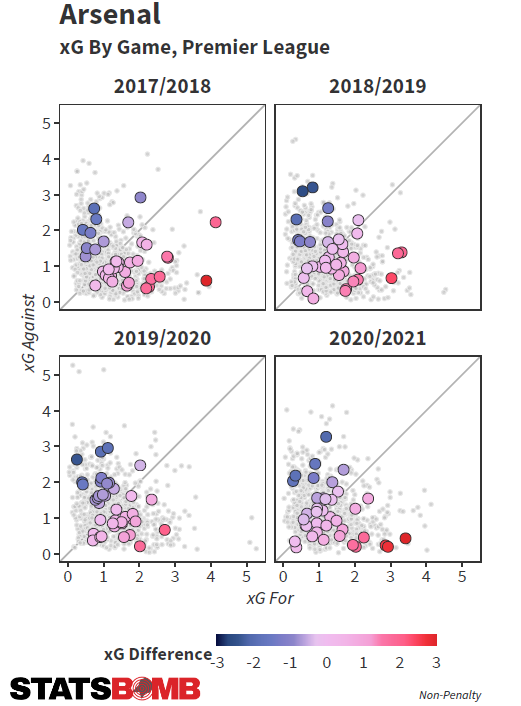
They shaved off 0.22 expected goals per game in defence, tightening up but still at the cost of some attacking output. Their open play xG per 90 was just 0.98 last season, compared with 1.42 per 90 in Arsene Wenger’s last season back in 2017/18. There’s still a long way to go to get back to that level.
Since replacing Unai Emery, Arteta's approach has been one of slowing the pace down and manipulating possession of the ball as much as possible. That was evident in Arsenal's passing trends last season: lots of deep passes in build-up play and very few cohesive or common patterns in the final third. While metrics highlighted some territorial domination (Arsenal entered the final third 49.2 times per game compared with their opponents' 42.4 entries), they struggled to translate that style into goals or a general threat. This must change if Arsenal are to break into Europe again.
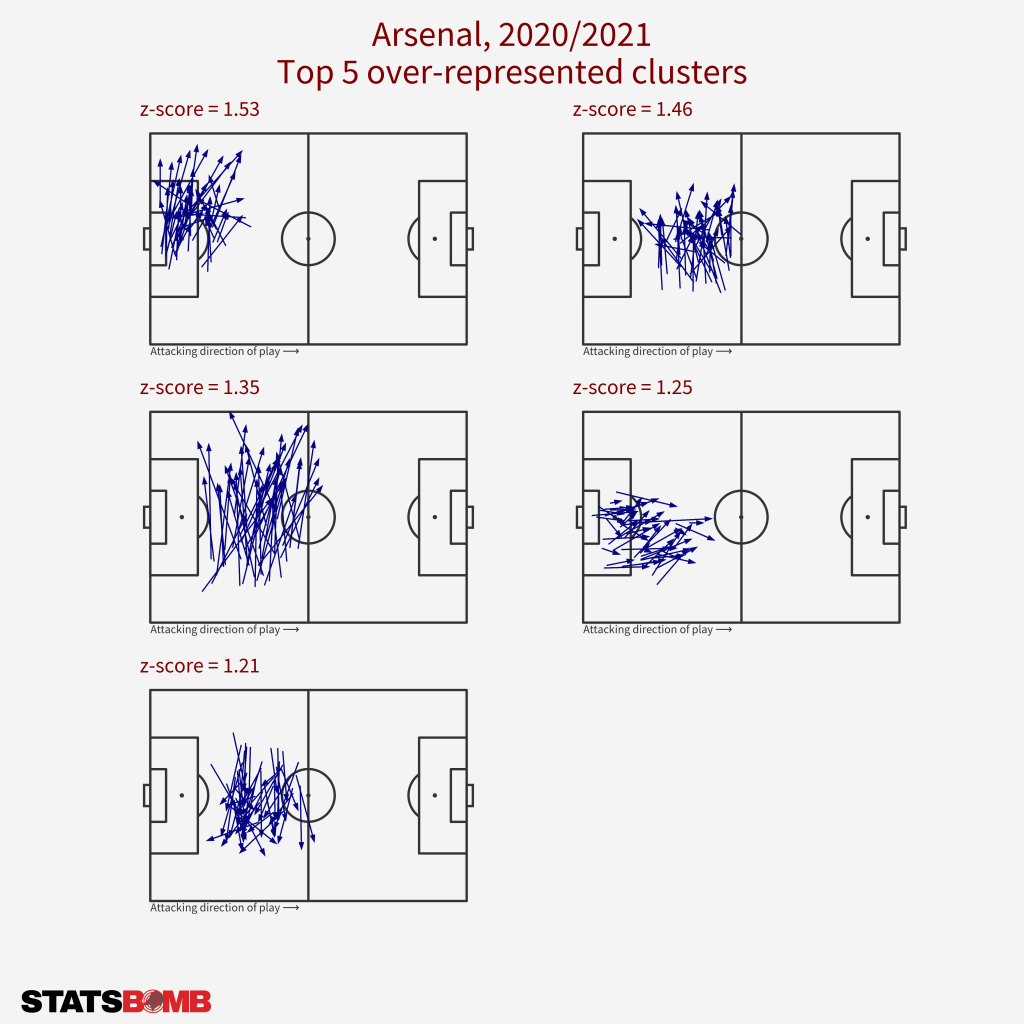
Without the ball, Arsenal opted for a deeper, more conservative defensive line and press -- something they may look to move away from in 2021/22. They were among the least frequent pressers in the Premier League last season (18th for total pressures, 19th for pressure regains) but it's possible Arteta employed this style as a short-term measure until the players were able to adjust to his longer term ideals. Arteta took a pragmatic approach, being more proactive when the team were favourites and more reactive when they were playing perceptibly stronger opponents.
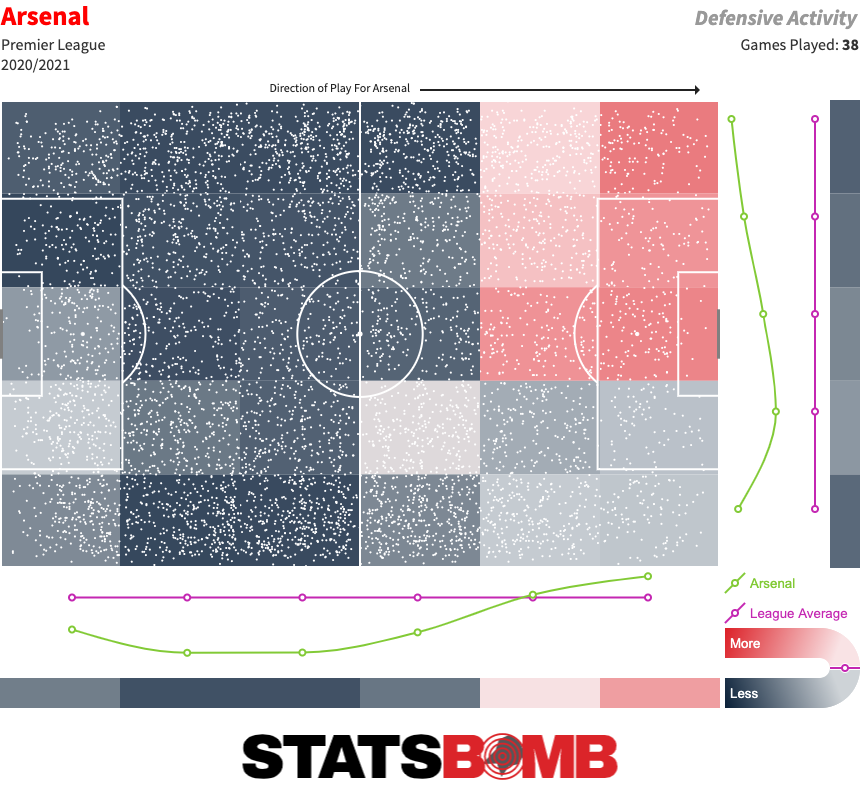
As mentioned, Arsenal did show some much-needed improvement in set-pieces. They dropped their set-piece xG conceded from 0.34 per game to 0.21 per game, which translated to conceding six fewer goals from set-pieces than they had done in 2019/20, a not-insignificant sum. They struggled in attack though, with just six goals scored from a paltry 0.18 set-piece xG per game, ranking 17th in the league in that metric. Things might move even further in the right direction this season as the club have signed set-piece coach and analyst Nicolas Jover from Manchester City in what should be a smart pickup given the impact he had on City’s set-pieces.
And now to review last season’s transfer business.
The two most notable signings were Thomas Partey and Gabriel. Partey emerged as a net-positive, but his lack of availability was a real cause for concern, whereas Gabriel started the season on fire before his performances dropped off as the matches piled up (not unsurprising for a younger player). He ended the season fluctuating between the bench and the starting XI.
The less said about Willian the better, but Martin Ødegaard’s January arrival did appear to be a smart pickup. He contributed just under 2000 minutes to a thin Arsenal squad, but overall his effect on the pitch was hit and miss.
The Current Crop
One of the biggest reasons for the uptick in Arsenal's performances was due to Arteta seemingly simplifying player roles within his game model, regardless of whether it was in his favoured 4-3-3 or the alternative 4-2-3-1 (his change to back three systems at the end of the season was mostly enforced). The complex system of positional shifts in and out of possession was gone, and players such as Emile Smith-Rowe, who could occupy space ahead of the ball and offer intelligent movement, were given chances. Boy genius Bukayo Saka was the biggest revelation of Arsenal’s season: his ability to simply find and manipulate space to his advantage was a big reason he became so important for the Gunners in 2020/21 and why he’ll be equally as important this coming season. Combine that with a versatility to play across the attacking band, in central midfield, or at full back/wing back and it's clear that Hale End has provided us with a good one.
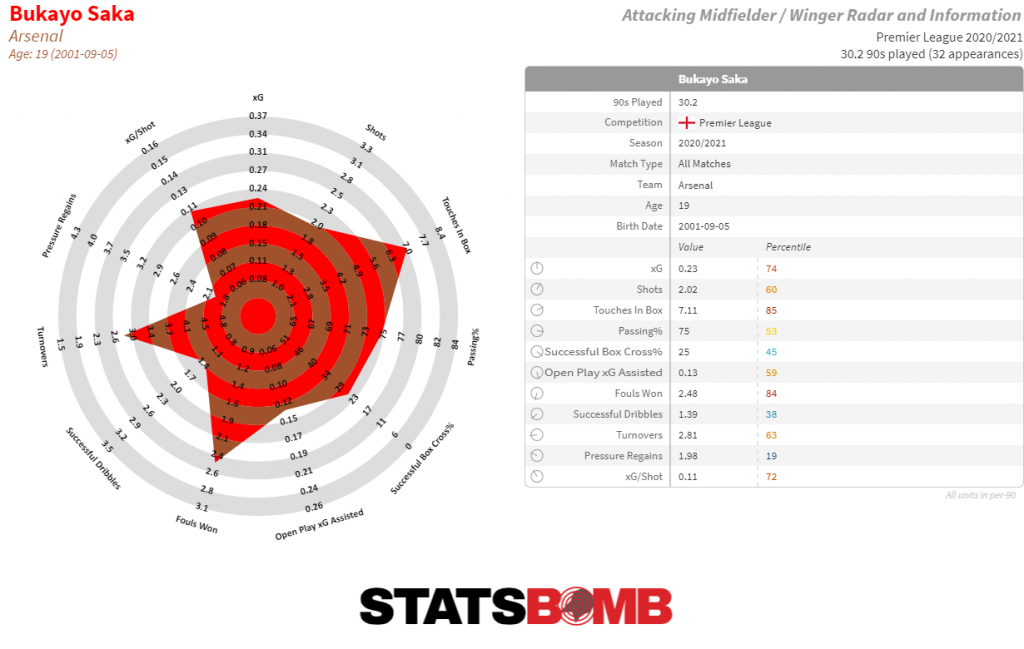
Besides Saka, we can look at StatsBomb’s new possession value model, On-Ball Value (OBV) to identify other players who could be regarded as important contributors to this Arsenal side. The results very much match the general fan perception of who the key men are, but one player who's perhaps a surprise inclusion towards the top of the list is Hector Bellerin, a player once adored by the fanbase but nowadays viewed as a weak spot in the starting XI. Without getting too deep into the woods, it’s likely he ranks favourably in OBV due to his dovetailing with the likes of Saka and Nicolas Pépé on the right flank, and while his final ball can be very hit-or-miss, his role in attacking moves which free up the wingers to create chances is still important.
| Player (Minimum 1,500 Minutes Played) | On-Ball Value Per 90 |
| Alexandre Lacazette | 0.31 |
| Kieran Tierney | 0.30 |
| Nicolas Pépé | 0.26 |
| Granit Xhaka | 0.22 |
| Hector Bellerin | 0.22 |
Transfers
The biggest arrival so far is that of Ben White from Brighton. His transfer could be key to replacing David Luiz’s significant contribution in build up, something that is required in Arteta's dogmatic approach to playing out from the back. White looks a very promising and accomplished player as a ball progressor, capable of punching the ball between the lines and providing a general comfort in possession.
Nuno Tavares, a young left back from Benfica, as been brought in to provide competition to Kieran Tierney. Left back was a bit of a problem area for the Gunners last season -- not due to Tierney’s ability (as shown above in his OBV contribution), but his inability to keep fit. Arteta tried many atypical solutions to this problem, playing Cedric Soares and even Granit Xhaka on the left flank in Tierney’s absence. In a small sample from his time in Liga NOS, Tavares looks to be an energetic and aggressive front-foot defender.
The only other signing thus far has been depth option Albert Sambi Lokonga from Anderlecht -- a young central midfielder who is versatile enough to fill a variety of positions/roles in the centre of the park. Using our "Similar Players" feature in StatsBomb IQ, Lokonga’s profile matches those of other well-known midfielders such as Joan Jordán of Sevilla, new Leicester City signing Boubakary Soumaré, and… former Arsenal player Matteo Guendouzi.
In preseason, Lokonga has looked a shrewd addition: always looking to play forward, good in tight areas and capable of dropping in and filling holes as teammates move forward. While he likely won’t be a first-choice option, and expectations must be tempered, I think he could surprise a few.
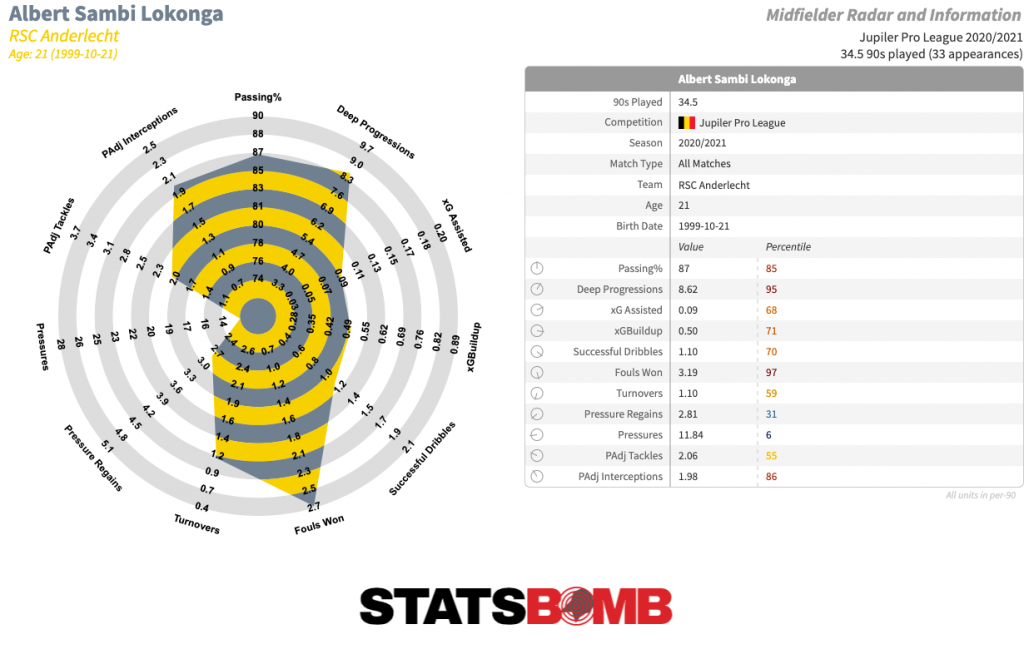
What’s The Expectation This Season?
As was the case with Emery before him, Arteta has had to juggle a number of difficult issues in order to put Arsenal back on track to where the fans expect them to be: in Europe. With this in mind, even the most die-hard of Arsenal fans would be optimistic to think that a return to the Premier League top four is a realistic possibility this season: their competitors are starting from a stronger base and simply have the upper hand right now.
That being said, with clear progression in the underlying numbers as last season went on, one would expect results to be better this time around and for Arsenal to close the gap on those above them. The decreased demands of their schedule give Arteta an opportunity to really lay some groundwork towards his optimal style of play and this could prove to be a benefit in the long term. Metrics have been good for a while, now it’s time for Arteta to translate that into results.
Want to read about another team?
The rest of our Premier League season previews can be found here
If you're a club, media or gambling entity and want to know more about what StatsBomb can do for you, please contact us at Sales@StatsBomb.com
We also provide education in this area, so if this taste of football analytics sparked interest, check out our Introduction to Football Analytics course
Follow us on Twitter in English and Spanish and also on LinkedIn
